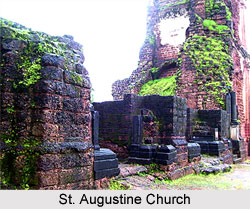 Ruins of the Church of St. Augustine church have been a popular tourist attraction and have been one of the most impressive churches in Goa. The church was built by 12 Augustian monks who built it with their combined efforts and resources in Goa on 3rd September 1572. The construction of the church began in 1597 and it continued till 1602. The Portuguese government had put a ban on them and they abandoned the church and the convent. Thus the continued neglect of the church turned it into a ruined structure.
Ruins of the Church of St. Augustine church have been a popular tourist attraction and have been one of the most impressive churches in Goa. The church was built by 12 Augustian monks who built it with their combined efforts and resources in Goa on 3rd September 1572. The construction of the church began in 1597 and it continued till 1602. The Portuguese government had put a ban on them and they abandoned the church and the convent. Thus the continued neglect of the church turned it into a ruined structure.
Architecture of Church of St. Augustine
The Church of St. Augustine that is now in complete ruins earlier had four stories, eight beautifully adorned chapels and a convent with many cells attached to the church. It also had four storeys with an arch in each. It was built of laterite and lime plaster. It was a huge building almost 46 m height. The tower formed part of the facade of the Church of St. Augustine. There were four altars. In 1931 the facade and half of the tower fell and some more parts of it collapsed in 1938. However, the soaring 46 metre high Bell Tower, without the bell still remains. It also bears the ruins of the front portion of the church making up a major portion of the ruins. The bell was removed and was initially shifted to Fort Aguada Lighthouse. Later it was finally placed in the church of Our Lady of Immaculate Conception at Panaji in 1871 which still works.
Around the year 1931 the facade and half of the tower fell in 1931 and the facade and half of the tower were lost. Gradually the full church began to collapse and now only the portico and the tower are present. As a result of these occurrences, the Government appropriated the property and sold the remains of the church in 1843. The church that was once supposed to be the biggest in Goa is still visited by many tourists from all over the world.
Renovation of Church of St. Augustine
ASI`s Mini Circle had conducted conservation work in the St. Augustine Church complex. The crevices that were located in the exposed walls, pillars and pilasters were consolidated. Water-tightening was also carried out. Scaffolding was erected on the tower. Due to contraction of soil, the stones began to break. Thus to avoid further damage, these stones were removed and re-fixed and had been given a concrete bed and sand soling. The four sides of the church have been re-plastered with a combination of lime-mortar. Even the stone railing of the bell tower was also strengthened and re-plastered.





















